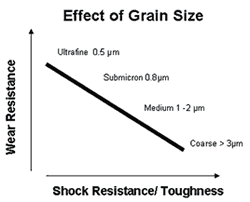Cemented Tungsten Carbide Offers Wear and Corrosion Resistance for Tooling
Using cemented tungsten carbide as a tooling material for core pins—especially in areas of high wear—can significantly reduce downtime.
Using cemented tungsten carbide as a tooling material for core pins—especially in areas of high wear—can significantly reduce downtime because of its wear and corrosion resistance, high compressive strength, thermal conductivity and anti-galling properties.
David LeMaistre, VP of Crafts Technology (Elk Grove Village, IL)—a manufacturer of wear parts, components and custom tooling made from cemented tungsten carbide—notes that this material is excellent for tooling in applications that experience premature wear. Cemented tungsten carbide is a unique blend of fine grain tungsten carbide powder and a small amount of binder material (usually cobalt, also in powder form), which is processed and sintered. The sintering process binds the tungsten carbide grains with the binder material to form the ultra hard material. The tungsten carbide grains provide the hardness and abrasion resistance and the binder material grains provide the ductility and toughness (see Figure 1).
Cemented tungsten carbide is available in many grades and is manufactured to almost any required combination of wear resistance, shock or impact resistance, and temperature resistance.
“The first step in selecting the proper grade of cemented tungsten carbide is to identify the mode of failure on the current tool,” he explains. “To determine the actual mode of failure; abrasive wear, corrosion or mechanical failure (breakage) a complete failure analysis study is conducted by the carbide manufacturer. The failure analysis process will identify the metallurgical and chemical properties of the material such as: binder material and content, grain size, hardness, density, transverse rupture strength (TRS), magnetic saturation and coercive force. From this data other important properties such as; compressive strength, modulus of elasticity, thermal conductivity and the coefficients of thermal expansion can be determined.
“By controlling two key properties—grain size and binder percentage—the characteristics of the tungsten carbide grade can be predicted,” LeMaistre continues. “The balance between the grain size of the tungsten carbide and the binder percentage and type of binder material must be achieved in order to get the desired combination of hardness (wear resistance) and toughness (strength).” (See Figure 2.)
The grade selection process requires a thorough understanding of the application—including the actual mode of failure of the current tool/part—and a complete knowledge of how to control the physical and mechanical properties of the available cemented tungsten carbide grades.
Cemented tungsten carbide is a proven material in solving premature wear problems because a grade can be customized for specific applications, LeMaistre maintains. “Through failure analysis, we can determine the mode of failure and tailor a grade that will solve the particular problem causing the failure,” he notes. “By controlling the relationship between the grain size and the binder percentage and type we can consistently control the final properties of the material and therefore predict the performance.”
Related Content
-
Moldmakers Deserve a Total Production Solution
Stability, spindle speed and software are essential consideration for your moldmaking machine tool.
-
Maintaining a Wire EDM Machine
To achieve the ultimate capability and level of productivity from your wire EDM on a consistent, repeatable and reliable basis, regular maintenance is a required task.
-
Machining Center Spindles: What You Need to Know
Why and how to research spindle technology before purchasing a machining center.








.jpg;maxWidth=300;quality=90)




